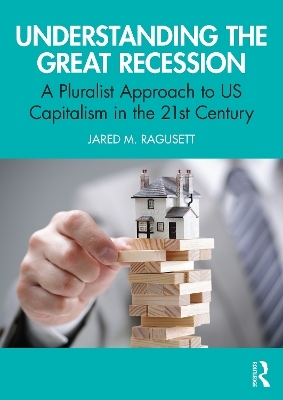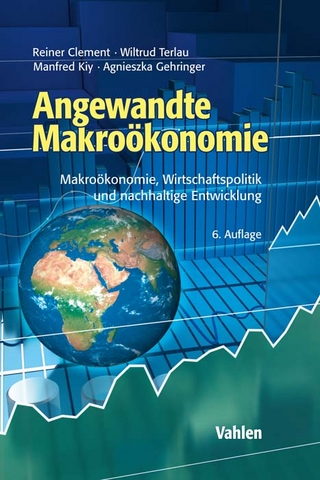
Understanding the Great Recession
A Pluralist Approach to US Capitalism in the 21st Century
Seiten
2023
Routledge (Verlag)
978-1-138-61818-3 (ISBN)
Routledge (Verlag)
978-1-138-61818-3 (ISBN)
Understanding the Great Recession provides an advanced theoretical and practical understanding of the Great Recession, using multiple approaches to economic analysis. An invaluable resource for students of economics, public policy, and other related fields.
The Great Recession, including the preceding events and the subsequent recovery period, has been the dominant feature of US capitalism in the 21st century. But what can we learn about economic behavior, policies, and relationships by studying this period of marked general decline? Understanding the Great Recession seeks to answer this question by facilitating an advanced theoretical and practical understanding of the Great Recession, using multiple approaches to economic analysis.
This textbook uses the Great Recession as a case study for understanding economic concepts, the conduct of policymaking, and competing schools of economic thought. It introduces readers to multiple perspectives on the crisis, including feminist, institutionalist, Marxian, monetarist, neoclassical, post-Keynesian, and stratification economics, amongst others. Divided into four parts, the textbook begins by introducing readers to the headline events of the crisis, and the major differences between neoclassical and heterodox economics. The second part investigates the lead-up to the crisis, beginning with the long-term restructuring of capitalism following the Great Depression, the housing market bubble, and the transmission of the 2008 financial crisis. The third part investigates the policy responses to the crisis, such as financial reform, monetary policy, and fiscal policy. In the final part, economic performance, the shift toward populism, and policy developments during the recovery are all analyzed.
Providing the basis for understanding the long-term trajectory of capitalism today, this book is an invaluable resource for students of economics, public policy, and other related fields.
The Great Recession, including the preceding events and the subsequent recovery period, has been the dominant feature of US capitalism in the 21st century. But what can we learn about economic behavior, policies, and relationships by studying this period of marked general decline? Understanding the Great Recession seeks to answer this question by facilitating an advanced theoretical and practical understanding of the Great Recession, using multiple approaches to economic analysis.
This textbook uses the Great Recession as a case study for understanding economic concepts, the conduct of policymaking, and competing schools of economic thought. It introduces readers to multiple perspectives on the crisis, including feminist, institutionalist, Marxian, monetarist, neoclassical, post-Keynesian, and stratification economics, amongst others. Divided into four parts, the textbook begins by introducing readers to the headline events of the crisis, and the major differences between neoclassical and heterodox economics. The second part investigates the lead-up to the crisis, beginning with the long-term restructuring of capitalism following the Great Depression, the housing market bubble, and the transmission of the 2008 financial crisis. The third part investigates the policy responses to the crisis, such as financial reform, monetary policy, and fiscal policy. In the final part, economic performance, the shift toward populism, and policy developments during the recovery are all analyzed.
Providing the basis for understanding the long-term trajectory of capitalism today, this book is an invaluable resource for students of economics, public policy, and other related fields.
Jared M. Ragusett, Associate Professor of Economics, Central Connecticut State University, United States.
Part I: Understanding the Crisis 1. Introduction to the Great Recession Part II: The Road to the Great Recession 2. US Capitalism Prior to 2008 3. The Housing Market Bubble (and Bust) 4. Financial Structure, Financial Crisis, and the Wall Street Bailouts 5. Competing Explanations of the Crisis Part III: Policy Responses to the Great Recession 6. Financial Reform 7. Monetary Policy Responses to the Great Recession 8. Fiscal Policy Responses to the Great Recession Part IV: The Recovery from the Great Recession 9. Inequality, Populism, and the Arc to Covid-19
| Erscheinungsdatum | 10.11.2023 |
|---|---|
| Zusatzinfo | 37 Tables, black and white; 47 Line drawings, black and white; 1 Halftones, color; 1 Illustrations, color; 47 Illustrations, black and white |
| Verlagsort | London |
| Sprache | englisch |
| Maße | 174 x 246 mm |
| Gewicht | 440 g |
| Themenwelt | Sozialwissenschaften ► Politik / Verwaltung |
| Wirtschaft ► Volkswirtschaftslehre ► Makroökonomie | |
| Wirtschaft ► Volkswirtschaftslehre ► Wirtschaftspolitik | |
| ISBN-10 | 1-138-61818-7 / 1138618187 |
| ISBN-13 | 978-1-138-61818-3 / 9781138618183 |
| Zustand | Neuware |
| Haben Sie eine Frage zum Produkt? |
Mehr entdecken
aus dem Bereich
aus dem Bereich
Volkswirtschaftslehre für eine sich ändernde Welt
Buch | Hardcover (2024)
De Gruyter Oldenbourg (Verlag)
44,95 €
Kompakt und prüfungsrelevant für Wirtschaftswissenschaftler
Buch | Softcover (2021)
Vahlen, Franz (Verlag)
11,90 €
Makroökonomie, Wirtschaftspolitik und nachhaltige Entwicklung
Buch | Hardcover (2022)
Vahlen (Verlag)
49,80 €


